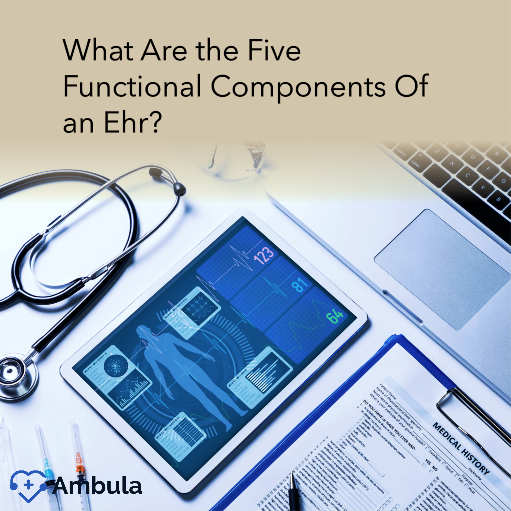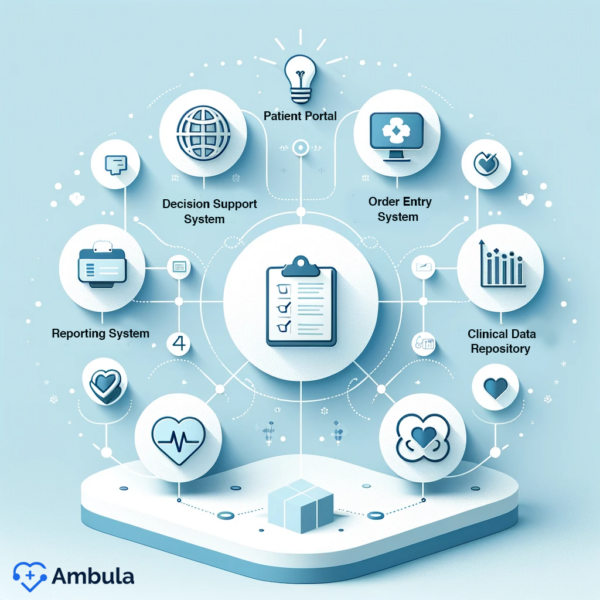
Electronic health records (EHRs) are digital versions of patients’ medical records. They contain a wide range of information, including demographics, medical history, medications, allergies, lab results, and imaging reports. EHRs can be used by various healthcare providers, including physicians, nurses, pharmacists, and specialists.
EHRs offer several benefits over traditional paper-based medical records. One of the pivotal functions of an EHR is to facilitate improved patient care. By centralizing information, EHRs enable healthcare providers to make better decisions by providing quick access to patient records. This accessibility reduces medical errors and ensures caregivers have the most updated information when making treatment decisions.
EHRs are made up of several different functional components. The five main functional components of an EHR are:
- Clinical data repository
- Decision support system
- Order entry system
- Patient Portal
- Reporting system
EHR functional requirements play a crucial role in ensuring the effectiveness and usability of these components. For example, the clinical data repository must have the capability to securely store and organize patient information, while the decision support system needs to provide accurate and timely clinical guidelines and alerts to assist healthcare providers in making informed decisions.
Clinical Data Repository
The clinical data repository is the core component of an electronic health record (EHR). It stores all of the patient’s clinical data, including demographics, medical history, medications, allergies, lab results, and imaging reports. The clinical data repository is typically organized using a standard data format, such as HL7 FHIR. This allows data to be easily shared between different EHR systems and other healthcare applications.
The clinical data repository is essential for several reasons. First, it provides clinicians with a single, centralized source of patient data. This makes it easier for clinicians to access the information they need to make informed decisions about patient care. Second, the clinical data repository can be used to generate reports on patient data, such as population health reports and quality improvement reports. These reports can be used to track trends in patient care and to identify areas where improvement is needed.
Decision Support System
A clinical decision support system (CDSS) is a computer-based system that provides clinicians with information and tools to help them make better decisions about patient care. CDSSs can be integrated into electronic health records (EHR) or stand-alone systems.
CDSSs use a variety of data sources to generate recommendations, including patient data (such as demographics, medical history, medications, and lab results), clinical guidelines, and evidence from research studies. CDSSs can provide clinicians with a variety of decision support tools, such as:
- Alerts and reminders: CDSSs can alert clinicians to potential drug interactions, clinical guidelines, and other relevant information.
- Order sets: CDSSs can provide clinicians with pre-built order sets for common procedures and conditions. This can help to reduce the risk of medical errors and to improve the efficiency of care delivery.
- Clinical scoring tools and risk calculators: CDSSs can provide clinicians with clinical scoring tools and risk calculators to help them assess the patient’s risk for developing certain diseases or complications. This information can be used to guide preventive care and treatment decisions.
- Evidence summaries: CDSSs can provide clinicians with evidence summaries from research studies to help them make informed decisions about patient care.
CDSSs can help clinicians to improve the quality of care by providing them with timely and accurate information, reducing the risk of medical errors, and helping them to follow clinical guidelines. CDSSs can also help to improve the efficiency of care delivery by reducing the time that clinicians spend on tasks such as order entry and reviewing patient records.
Order Entry System
An order entry system (OES) is a computer-based system that allows clinicians to order tests, medications, and other patient services electronically. OESs are integrated into electronic health record (EHR) systems, and various healthcare providers, including physicians, nurses, and pharmacists, use them.
OESs typically allow clinicians to select orders from a pre-built list of options. Clinicians can also enter custom orders. Once an order has been entered, it is electronically transmitted to the appropriate healthcare provider or department. OESs also track the status of orders so that clinicians can see when an order has been completed.

Patient Portal
A patient portal is a secure online platform that gives patients convenient, 24-hour access to personal health information from anywhere with an Internet connection. For neurology patients, a neurology EMR integrated with a patient portal allows them to view test results, manage appointments, and communicate with their neurology specialist, enhancing patient engagement and care continuity.
Patient portals offer several benefits to patients, including:
- Access to medical records: Patients can use the patient portal to view their medical history, lab results, imaging reports, and other medical records. This can help patients to better understand their health and to be more informed participants in their care.
- Communication with healthcare providers: Patients can use the patient portal to send and receive secure messages with their healthcare providers. This can be a convenient way to ask questions, request appointments, and refill prescriptions.
- Scheduling appointments: Patients can use the patient portal to schedule appointments with their healthcare providers. This can help to save patients time and hassle.
- Paying bills: Patients can use the patient portal to pay their medical bills online. This can be a convenient and secure way to pay bills.
Patient portals can also offer several benefits to healthcare providers, including:
- Improved patient engagement: Patient portals can help improve patient engagement by giving patients more control over their care and making it easier for them to communicate with their healthcare providers.
- Reduced workload: Patient portals can help to reduce the workload on healthcare providers by automating tasks such as scheduling appointments and refilling prescriptions.
- Improved quality of care: Patient portals can help to improve the quality of care by providing patients with access to their medical records and by making it easier for them to communicate with their healthcare providers.
Reporting System
A reporting system is a software component of an electronic health record (EHR) that generates reports on patient data. Reporting systems can be used to generate a wide variety of reports, such as:
- Population health reports: These reports provide information about the health of a population, such as the prevalence of chronic diseases and the utilization of healthcare services.
- Quality improvement reports: These reports identify areas where the quality of care can be improved, such as patient outcomes and compliance with clinical guidelines.
- Regulatory compliance reports: These reports ensure that healthcare providers are meeting regulatory requirements, such as reporting certain diseases to the government.
- Financial reports: These reports track financial data, such as revenue and expenses.
Reporting systems typically work by allowing users to define the criteria for the report, such as the patient population to be included in the report and the data elements to be included in the report. Once the criteria have been defined, the reporting system generates the report and displays it to the user.
Administrative Processes
One of the most significant impacts of EHR lies in its ability to optimize administrative processes, leading to improved efficiency, reduced costs, and enhanced patient satisfaction.
Automated Billing and Claims Management: Medical coding and billing can be a complex and time-consuming process. EHRs streamline this process by automatically generating accurate and compliant claims, reducing the risk of errors and delays. This translates to faster reimbursements for healthcare providers and improved cash flow.
Enhanced Patient Communication and Engagement: EHRs facilitate secure communication between patients and their providers through e-messaging portals. Patients can easily access their medical records, test results, and medication information, leading to increased awareness and participation in their care.
Reduced Administrative Burden: By automating routine tasks and eliminating paper-based processes, EHRs free up valuable time for healthcare providers, allowing them to focus on patient care. This translates to improved patient satisfaction and better clinical outcomes.
Benefits of EHRs
EHRs offer several benefits to patients and healthcare providers, including:
- Improved efficiency: EHRs can help improve healthcare delivery efficiency by streamlining workflows and reducing the need for manual data entry.
- Improved accessibility: EHRs can be accessed from anywhere with an internet connection, making it easier for patients to get the care they need.
- Improved security: EHRs are typically more secure than paper-based medical records, as they are less likely to be lost or stolen.
- Improved quality of care: EHRs can help to improve the quality of care by providing clinicians with easy access to patient data and by helping to reduce medical errors.
Conclusion
EHRs are essential tools for modern healthcare. The five main functional components of an EHR are the clinical data repository, decision support system, order entry system, patient portal, and reporting system. EHRs offer a number of benefits to patients and healthcare providers, including improved efficiency, accessibility, security, and quality of care.




